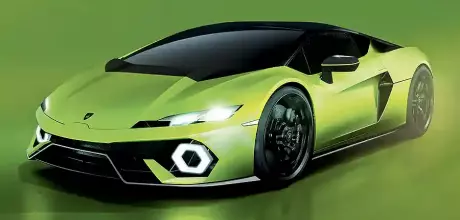Lamborghini's upcoming junior supercar
Lamborghini’s highly anticipated successor to the renowned Huracán is poised to redefine the paradigm of junior supercars, marking a revolutionary transition into the realm of electrification within the Italian automaker's lineup. Scheduled for unveiling in the forthcoming months and slated for market release by the end of 2024, this new entry-level supercar signifies a departure from Lamborghini's trademark naturally aspirated V10 engine, embracing a transformative plug-in hybrid powertrain built around an in-house engineered V8.
Visually, the upcoming junior supercar embodies the cutting-edge design ethos championed by Lamborghini's head of design, Mitja Borkert. Drawing inspiration from the flagship V12 PHEV Revuelto, this new iteration boasts a captivating silhouette that echoes a futuristic 'spaceship' aesthetic. Sporting iconic Lamborghini hallmarks such as the distinctive hexagonal exhaust, Y-shaped LED light designs, and strategically integrated air channels across its body for heightened downforce, the car maintains a striking presence while inheriting the foundational 'monofuselage' carbon fiber monocoque from the Revuelto.
However, while the junior supercar embraces similar design principles, it's poised to leverage cost-efficient aluminum in its structural elements, departing from the extensive use of exotic composites found in its flagship counterpart. Aligning with its more accessible positioning, this approach allows for a judicious utilization of premium materials primarily in pivotal structural segments, reminiscent of the strategy employed in the Huracán and its sibling, the Audi R8.
Distinctively shorter in its platform compared to the Revuelto, the upcoming model aims for a visual distinction, with a strategic reduction in length to differentiate itself. This strategic shift in platform, inheriting the monofuselage chassis, paves the way for the electrification of the Huracán successor, making it Lamborghini's third plug-in hybrid electric vehicle after the Revuelto and the revamped 2024 edition of the Urus SUV.
While specifics about the V8 powertrain and its relation to the Urus's 4.0-liter twin-turbo setup remain undisclosed, Lamborghini is poised to engineer a bespoke engine, emphasizing a unique driving experience and character for the successor to the Huracán. Building on the success of the Revuelto's deployment of Yasa's axial flux electric motors for weight efficiency and power enhancement, a similar approach could be adopted for the junior supercar.
Yet, the configuration of motors, whether dual motors on the front axle accompanied by a third integrated in the gearbox as seen in the 1001bhp Revuelto, and the drivetrain variants (rear- or four-wheel-drive) for the successor remain subjects of anticipation.
Expectedly, a lightweight battery, possibly akin to the 3.8kWh pack in the Revuelto, will be nestled within the central spine of the chassis, promising an electric-only range of fewer than 10 miles. Beyond mere gains in fuel economy and emissions, this setup promises dynamic advantages. Similar to the Revuelto's prowess, torque vectoring at the front aids in handling neutrality, while the rear motor compensates for the high-revving engine's low-end performance, hinting at a potential bias towards high revs for the successor's engine characteristics.
Anticipated to be produced on the same line as the Revuelto, Lamborghini's Huracán successor will mark a milestone as both supercars roll off the assembly line in series. This synchronicity in production is made possible by the shared architectural and electrical components, underscoring Lamborghini's commitment to innovation and synergy across its lineup.
Scheduled for a 2024 debut, the Huracán successor is poised to echo the design cues of the Revuelto, promising a futuristic and captivating supercar experience that encapsulates Lamborghini's tradition of groundbreaking automotive excellence.


